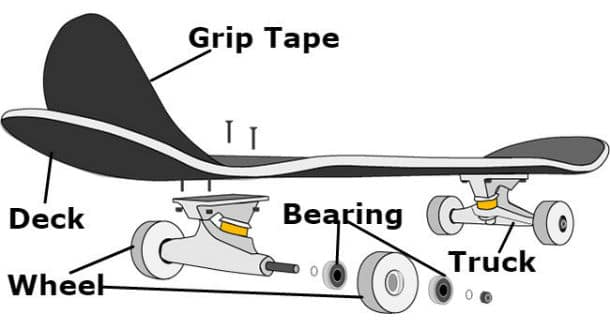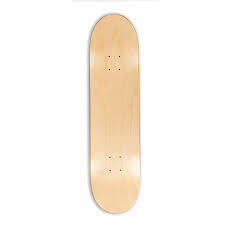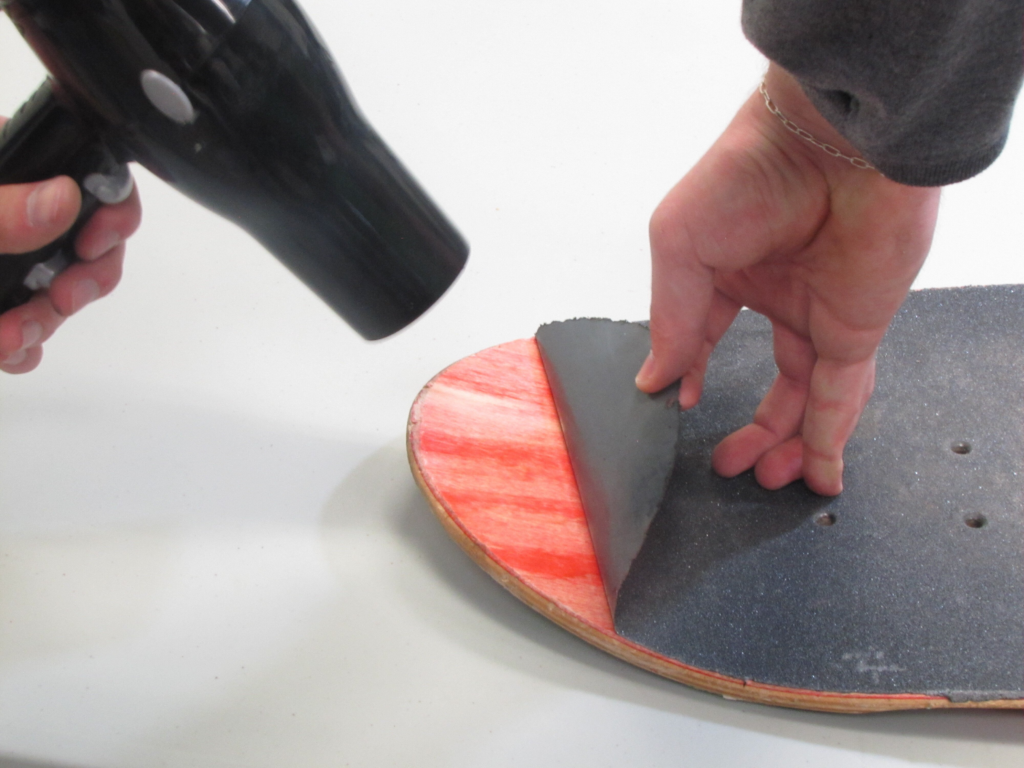Master the art of skateboarding with a deep dive into the parts of a skateboard. Learn how selecting the perfect setup, from deck to trucks, can define your riding style
A skateboard is a simple machine, but it is made up of several important parts that work together to allow the rider to perform tricks and maneuvers. Whether you are a beginner or a seasoned pro, it is important to understand the different parts of a skateboard and how they work together.
The three main parts of a skateboard are the deck, trucks, and wheels. However, there are a number of other parts that may be added to a skateboard, such as risers, shock pads, rails, and hardware.
Parts of a skateboard diagram

The Skateboard Deck
The skateboard’s primary component is the deck. It is the platform that the rider stands on. Skateboard decks are typically made of wood, but some companies also make decks out of carbon fiber or other materials.

Skateboard decks come in a variety of shapes and sizes, depending on the type of skateboarding you want to do. Street skaters typically prefer smaller, narrower decks with a steep kicktail, while transition skaters prefer larger, wider decks with a mellow kicktail.
The deck is also characterized by its concave and rocker. Concave refers to the curvature of the deck from the edges to the center. Rocker refers to the curvature of the deck from the nose and tail to the center.
Concave and rocker help the rider to lock their feet onto the deck and make it easier to control. The nose and tail of a skateboard deck are the two ends of the board. The nose is typically slightly wider and longer than the tail.
The tail is used to pop the board into the air and perform tricks, while the nose is used to grind and slide on rails and other obstacles.
The kicktail is the upturned end of a skateboard deck. It is used to pop the board into the air and perform tricks. The wheelbase is the distance between the two axles on a skateboard deck.
A shorter wheelbase makes the board more responsive and easier to turn, while a longer wheelbase makes the board more stable and easier to ride at high speeds.
Griptape is a coarse sandpaper-like material that is applied to the top of a skateboard deck. It provides traction and helps the rider to keep their feet on the board.
The Grip Tape
Beneath your feet lies the grip tape, a gritty, sandpaper-like surface that ensures your shoes grip the deck. Properly applying and maintaining grip tape is crucial for maintaining control and preventing slipping, especially during tricks and maneuvers. Some skaters get creative with grip tape designs, adding a personal touch to their boards if you want to know how to put grip tape on a skateboard read this

Trucks and Wheels
Trucks
Trucks are the metal assemblies that connect the wheels to the deck. They allow the board to turn and provide stability.
Trucks are made up of several parts, including the hangers, baseplates, kingpin, bushings, and axles. The hangers are the two metal parts of a skateboard truck that the wheels are attached to.
The baseplates are the two metal plates that the hangers are attached to. The kingpin is the central bolt that holds the hangers and baseplates together.
The bushings are rubber cushions that are placed between the hangers and baseplates. They absorb shock and help to steer the board. The axles are the metal rods that the wheels are attached to.
Wheels
Skateboard wheels are made of urethane, which is a durable and elastic material. Wheels come in a variety of sizes and hardness, depending on the type of skateboarding you want to do.
Street skaters typically prefer smaller, harder wheels, while transition skaters prefer larger, softer wheels. Skateboard wheels have two bearings per wheel. Bearings enable the wheels to rotate with smoothness and efficiency. You can learn more skateboard trucks and wheels guide
Other parts
Risers are small metal or plastic spacers that are placed between the deck and the trucks. They raise the deck up slightly, which can help to prevent wheel bite.
Shock pads are thin pieces of foam that are placed between the deck and the trucks. They absorb shock and help to reduce vibrations.
Rails are thin metal or plastic strips that are attached to the sides of the deck. They protect the deck from damage and provide a place to grind and slide on rails and other obstacles.
Hardware includes the bolts and nuts that are used to attach the trucks and wheels to the deck.
Conclusion
The different parts of a skateboard work together to allow the rider to perform tricks and maneuvers. When choosing parts for your skateboard, it is important to consider the type of skateboarding you want to do and your personal preferences.
Additional tips from a skateboard expert:
- When choosing a deck, be sure to select one that is the right size and shape for you. If you are a beginner, you may want to start with a smaller, narrower deck. As you progress, you can move up to a larger, wider deck.
- When choosing trucks, be sure to select ones that are compatible with your deck. Trucks come in a variety of widths, so make sure to choose ones that are the right width for your deck.
- When choosing wheels, be sure to select ones that are the right size and hardness for you. If you are a beginner, you may want to start with smaller, harder wheels. As you progress, you can move up to larger, softer wheels.
- Be sure to maintain your skateboard regularly. This includes cleaning
FAQ’S
Q: What are the most important skateboard parts?
A: The most important skateboard parts are the deck, trucks, and wheels. The deck is the platform that you stand on, the trucks allow the board to turn, and the wheels provide traction and allow the board to roll.
Q: What size skateboard deck should I get?
A: What size of skateboard should you get ,The size of skateboard deck that you get depends on your height, weight, and riding style. If you are a beginner, you may want to start with a smaller, narrower deck. As you progress, you can move up to a larger, wider deck.
Q: What type of skateboard trucks should I get?
A: There are two main types of skateboard trucks: high trucks and low trucks. High trucks are better for transition skating, while low trucks are better for street skating.
Q: What type of skateboard wheels should I get?
A: There are two main types of skateboard wheels: hard wheels and soft wheels. Hard wheels are better for street skating, while soft wheels are better for transition skating.
Q: How often should I clean and maintain my skateboard?
A: You should clean and maintain your skateboard regularly. This includes cleaning the deck, trucks, and wheels with a damp cloth. You should also check the bearings regularly and lubricate them as needed.
Here are some additional FAQs:
Q: What is wheel bite?
A: Wheel bite is when the wheels rub against the deck. This can happen if the trucks are too loose or if the wheels are too big. Wheel bite can cause the rider to lose balance and fall.
Q: What is a concave?
A: A concave is the curvature of the deck from the edges to the center. Concave helps the rider to lock their feet onto the deck and makes it easier to control.
Q: What is a rocker?
A: A rocker is the curvature of the deck from the nose and tail to the center. Rocker helps the rider to pop the board into the air and perform tricks.
Q: What is a kicktail?
A: A kicktail is the upturned end of a skateboard deck. It is used to pop the board into the air and perform tricks.
Q: What is a wheelbase?
A: The wheelbase is the distance between the two axles on a skateboard deck. A shorter wheelbase makes the board more responsive and easier to turn, while a longer wheelbase makes the board more stable and easier to ride at high speeds.
I hope this helps!